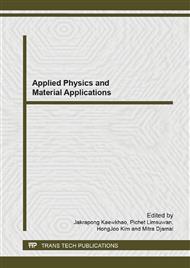p.311
p.315
p.319
p.323
p.327
p.331
p.335
p.339
p.343
Decreased Thermal Conductivity of CaMnO3 by Added-CNTs
Abstract:
The CaMnO3 compound is synthesized by solid state reaction method. The precursor powder of calcium carbonate (CaCO3) and manganese oxide (MnO2) are mixed by ball milling then calcined at 850°C for 10 h and sintering at 1,150 °C for 36 h to obtain the calcium manganese oxide (CaMnO3) compound. The compound was doped the carbon nanotubes (CNTs) 2%, 4%, 6%, 8% and 10% by molar ratio following the calcinations and sintering process. The morphology and crystallography of the samples are analyzed by the X-ray diffraction (XRD) technique and scanning electron microscope (SEM). The Seebeck coefficient (S), electrical resistivity (ρ), thermal conductivity (κ) and dimensionless figure of merit were anlyzed. It results shown in a good thermoelectric properties after doping CNTs.
Info:
Periodical:
Pages:
327-330
Citation:
Online since:
September 2013
Authors:
Keywords:
Price:
Сopyright:
© 2013 Trans Tech Publications Ltd. All Rights Reserved
Share:
Citation:


